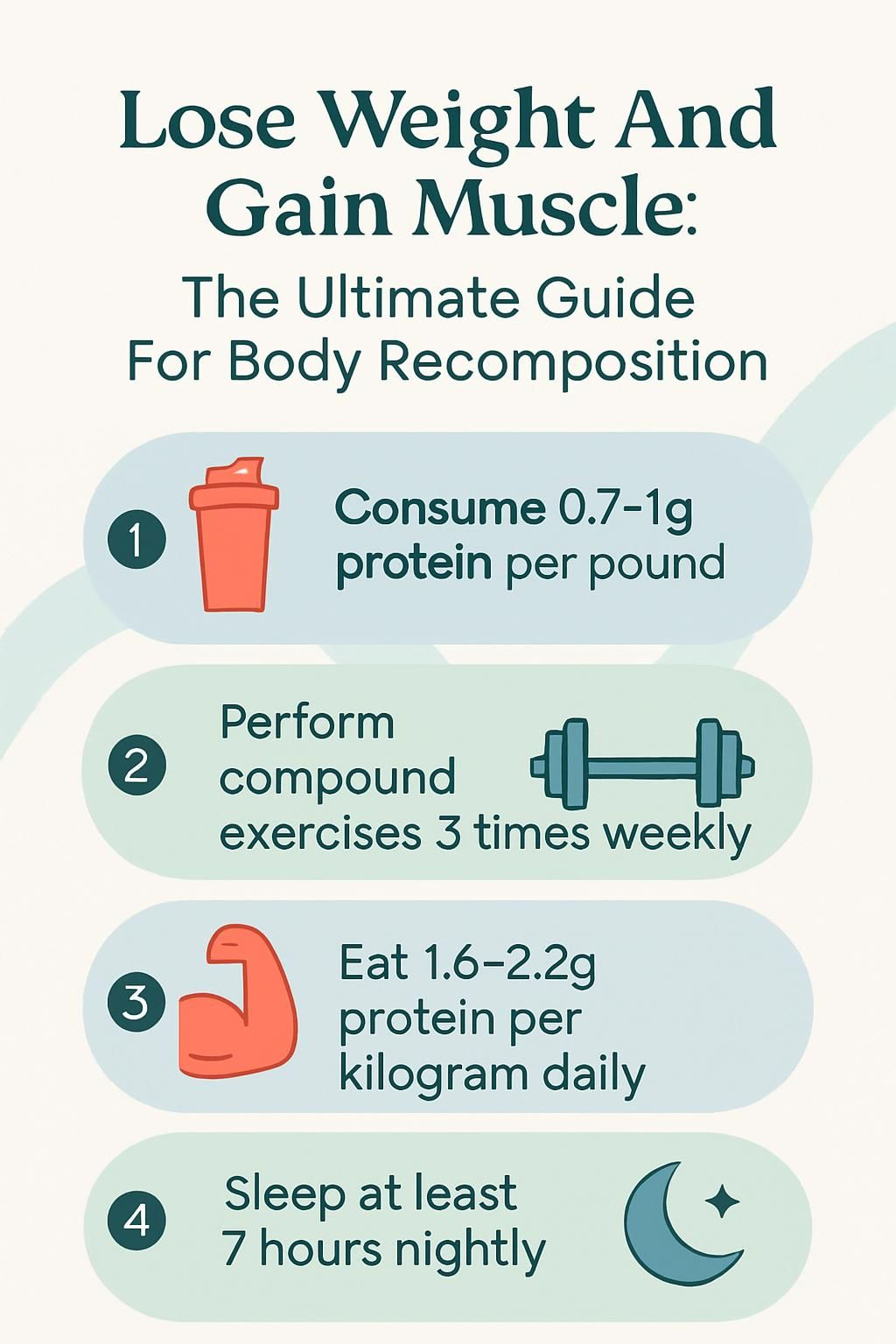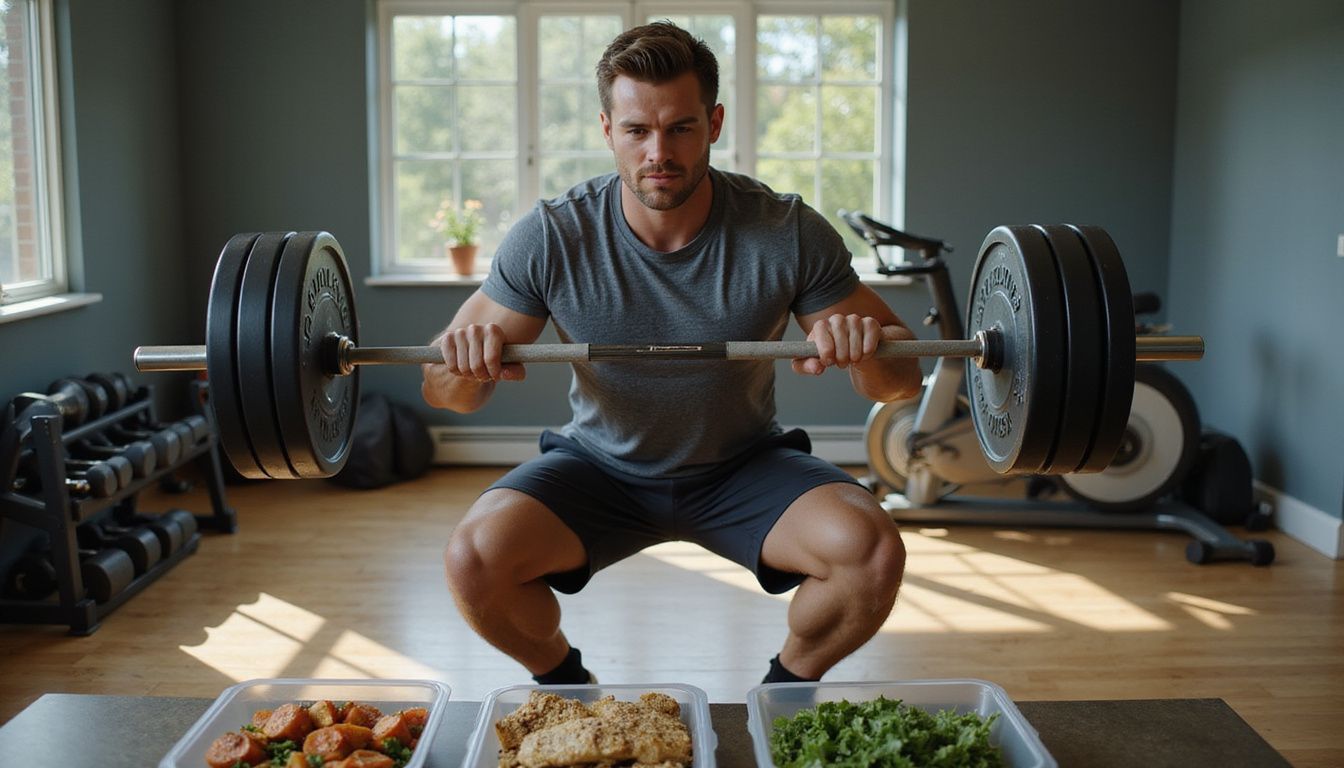Lose Weight And Gain Muscle: The Ultimate Guide For Body Recomposition
Our Nutrition Assistant AI Suite will transform your body. You will lose fat, get toned, and build muscle. Gain confidence and optimal health.
You might feel stuck trying to lose fat and gain muscle at the same time. It is possible with the right workout plan, smart nutrition, and steady habits. Researchers call this body recomposition, a shift in your ratio of fat to lean body mass.
This guide gives you clear, evidence-based steps. You will learn how to use strength training, a high protein diet, simple nutrition tactics, and easy tracking methods. Start now and see how small daily actions reshape your health and physique.
Key Takeaways
- Body recomposition, losing fat and building muscle, is possible with consistent strength training, high protein intake, and smart calorie control (Hall KD et al., 2012).
- Compound lifts like squats and deadlifts three times per week improve muscle mass and cut body fat more than isolation moves or cardio alone (Schoenfeld BJ, 2016; Paoli A et al., 2010).
- Daily protein of 1.6–2.2 grams per kilogram supports lean mass in a calorie deficit, according to sports nutrition reviews.
- Track with DEXA scans, circumference tape, and progress photos for reliable feedback on fat loss and muscle gain.
- Sleep matters. Less than seven hours per night leads to more muscle loss during weight reduction efforts.

What is body recomposition and how does it work?

Body recomposition means you lower body fat while adding muscle at the same time. The goal is not just to lose weight. You improve your ratio of fat to lean mass so your body looks and performs better.
You do this with strength training, some cardio, and a higher protein intake. Studies show you can gain muscle in a small calorie deficit if you lift weights and eat enough protein. Protein protects muscle while your body burns stored fat for energy.
Adjust calories based on progress each week or month. Small changes add up. A coach once told me something that stuck.
Recomposition is less about losing weight fast, and more about changing what your weight is made of.
Consistency in training and nutrition drives most results. Keep showing up and your body will follow.
What are the key principles for losing fat and gaining muscle?
You need the right mix of energy intake and training stress. That mix supports muscle hypertrophy, which means muscle growth, while body fat goes down. A balanced approach lets you make both changes at once.
Why is calorie balance important for body recomposition?
Calorie balance controls whether you gain, keep, or lose tissue. Muscle growth needs energy from food. Fat loss needs a calorie deficit, which means eating fewer calories than you burn.
Research shows a deficit reduces body fat while strength training and higher protein help you hold on to lean mass. I once logged every meal with a basic app for my first recomposition phase. Portion control and tracking helped me lose extra weight while my dumbbell press numbers climbed.
Reviews suggest people who track intake hit goals more accurately than those who do not (Hall KD et al., 2012). Use a steady meal plan with enough protein, carbs, and fats. Your plan should fit your schedule and support both weight loss and lean muscle gains.
How does strength training help with body recomposition?
Once your calorie target is set, strength training does the heavy lifting. It sends a growth signal that turns food energy into new muscle. More muscle also raises your resting metabolism, so you burn more calories all day.
Progressive overload, which means gradually adding weight, reps, or sets, drives hypertrophy. Simple moves work. Bicep curls, squats, push-ups, and calf raises cover many key muscle groups.
Train three to five days per week. Clinical trials show the best changes in lean mass and fat loss happen when regular resistance work is paired with higher protein. Diet alone rarely matches these results.
Strength training helps your body use calories to build, not store.
How much protein should you eat to maximize results?
Lifting alone is not enough. You need protein to repair and grow muscle after training. Aim for 0.7–1 gram of protein per pound of body weight each day. That means a 150 pound person targets 105–150 grams daily from foods like eggs, dairy products, lean meats, fish, beans, and protein powders.
This intake supports recovery and strength while you manage your calories for fat loss or small muscle gain.
Nutrition strategies for effective body recomposition
Nutrition shapes your ability to lose fat while building muscle mass. Focus on protein, carbs, healthy fats, hydration, and simple habits you can keep.
What macronutrient ratios support fat loss and muscle gain?
High protein is essential. Target 1.6–2.2 grams per kilogram of body weight per day. Protein supports muscle growth with training and helps control hunger in a deficit.
If you train often, let carbohydrates supply around 40–50 percent of daily calories. Carbs fuel workouts and recovery. Fill the rest with fat, usually 20–30 percent of calories, to support hormones and satiety without pushing fat gain.
These ranges give your body fuel for workouts while guiding steady fat loss over time.
Which high-protein foods are best for body recomposition?
Food choice matters. Pick options that deliver protein with useful nutrients and moderate calories.
- Chicken or turkey breast, about 26 grams of protein per 100 grams, low in fat, great for hypertrophy in a deficit.
- Fish such as salmon or tuna, up to 25 grams per 100 grams, plus omega-3 fats that support training and health.
- Greek yogurt, around 10 grams per serving, supports gut health and is a quick post-workout snack.
- Eggs, about 6 grams each, a complete protein source with key micronutrients.
- Cottage cheese, rich in casein, roughly 14 grams per half cup, helpful for overnight repair.
- Lean beef, 22–31 grams per 100 grams, plus iron and zinc for performance and recovery.
- Lentils or chickpeas, 8–9 grams per cooked half cup, plant protein with fiber for fullness.
- Protein powders, whey or plant blends, 20–30 grams per scoop, handy right after training.
- Nuts such as almonds or peanuts, 6–7 grams per ounce, nutrient dense and portable.
- Tofu or tempeh, up to 20 grams per serving, versatile vegan choices for many meals.
Mixing several of these kept my meals interesting while I pushed pull-ups and fly movements at the gym.
How do you manage calorie deficits and surpluses effectively?
Use a food scale or a tracking app to log portions. For fat loss, set a daily deficit of 250–500 calories below maintenance. For lean gains, try a small surplus of about 200 calories.
Weigh yourself at the same time of day, several days per week, and look at the weekly average. Track waist measurements and consider DEXA for deeper body composition data. Small macro adjustments affect energy in training, so protect protein first. Then fine-tune carbs and fats to feel strong without stalling progress.
Best exercises to build muscle and lose fat
The right exercises train many muscles at once, increase strength and hypertrophy, and boost your calorie burn. Think big movements first, then add support work.
What are compound movements and why are they effective?
Compound movements train several muscle groups at once. These include squats, deadlifts, bench presses, pull-ups, and chest fly variations. Each rep moves multiple joints, so you get more work done in less time.
Squats use hips, knees, and ankles while engaging legs and back. Deadlifts hit your glutes, hamstrings, lower back, forearms, and grip at the same time.
Compound lifts burn more calories than isolation moves like biceps curls or triceps extensions. They also drive greater strength and hypertrophy because you can use heavier loads and train more muscle mass (Schoenfeld, 2016). This stress builds fat-free mass and improves your body composition over time.
I started as an overweight teen. My coach had me squat and deadlift three days per week. Progress sped up compared to classmates who only used machines.
Studies report that compound training helps people maintain weight more easily due to higher basal metabolic rate after lifting (Paoli, 2010). That is why these lifts fit so well in a recomposition plan.
How does resistance training contribute to body recomposition?
Resistance training is your main stimulus for muscle growth. Lifting creates tiny tears in muscle fibers. Your body repairs them stronger, which increases lean mass and your resting calorie burn.
You can even gain or maintain muscle in a calorie deficit if you lift and eat enough protein. Exercises like squats, deadlifts, and fly movements hit large muscle groups and save time. Training three days per week can lower body fat percentage while improving muscle size and quality in lab studies.
Track both scale weight and body fat changes for a complete picture. Strength training is vital if you want to reduce fat and grow muscle at once.
Can high-intensity interval training (HIIT) help with fat loss?
HIIT uses short hard bursts followed by easy effort or rest. Research shows it can reduce body fat faster than steady cardio for many people. A 2019 review reported roughly 28 percent greater fat loss with HIIT compared to moderate-intensity cardio.
HIIT also raises your metabolism after the workout. I used two HIIT sessions per week during a recent recomposition phase. My waist dropped an inch in six weeks while my lifts stayed strong. Pair HIIT with compound lifting and solid nutrition for best results.
How important is protein in body recomposition?
Protein, the nutrient made of amino acids, drives recovery and muscle growth. It helps you keep lean mass during calorie cuts and supports strength gains when you train hard.
What is the recommended daily protein intake for muscle gain?
Most experts suggest 0.7–1 gram of protein per pound of body weight each day. If you weigh 150 pounds, aim for 105–150 grams. That range supports repair and growth whether you are in a deficit or a small surplus.
Whole foods like lean meats, fish, eggs, Greek yogurt, nuts, and beans help you hit the target. During my last recomposition phase, I tracked intake in a food journal to match these numbers. Eating near the top of the range can reduce muscle loss during weight cuts or very-low-calorie diets.
Meal timing also helps your results.
When should you consume protein for optimal results?
Eat a protein-rich meal within two hours after lifting. That timing helps drive muscle protein synthesis, which is the process of building new muscle.
Spread protein across the day. Aim for about 20–40 grams at each meal or snack. A slow-digesting option like cottage cheese before bed may boost overnight repair. If you train hard with compound lifts or fly variations, getting protein soon after your session keeps progress steady and helps guard against sarcopenia, which is age-related muscle loss.
How can you track progress during body recomposition?
Use simple, repeatable methods. Combine measurements that show fat loss, lean mass changes, and visual progress. Each tool adds a piece of the puzzle.
What methods measure body fat percentage accurately?
Dual-energy X-ray absorptiometry, or DEXA, is one of the most precise. It uses low-dose X-rays to measure bone, fat, and lean mass. Hydrostatic weighing calculates fat by water displacement and is a research standard.
Bioelectrical impedance analysis, or BIA, estimates fat levels with a small current. Skinfold calipers measure pinch sites, but results depend on the tester’s skill. Many people blend these methods during a program to get a clearer picture of progress.
How do you monitor muscle growth effectively?
Use a tape measure to track arms, chest, waist, hips, and thighs every few weeks. Photos in the same lighting and poses reveal changes the scale can miss.
Weigh yourself on a reliable scale. Muscle gain can offset fat loss on the scale, so look at strength trends too. If you lift heavier or do more reps over time, your training is working. Some people also use BIA devices to estimate lean mass. Combine tools and watch for steady changes without pushing into pain or signs of overtraining.
Why use progress photos and measurements?
The scale cannot show shape. One pound of muscle takes up less space than one pound of fat. Photos reveal posture, tone, and definition. Waist, arm, chest, and hip measurements capture change even when body weight holds steady.
These records keep you accountable. You will notice trends sooner, like losing inches even if calories remain consistent. Rely on photos and tape alongside BMI and other measures to see the full story.
What are common myths about body recomposition?
Myths can slow your progress, like thinking you must avoid carbs or only do endless fly exercises. Clear the noise so your plan stays simple and effective.
Is it true you can’t gain muscle in a calorie deficit?
It is possible, especially if you are new to lifting or coming back after time off. A 2016 study showed overweight adults gained up to about 2 pounds of muscle while losing fat in twelve weeks with resistance training and higher protein intake (Longland TM et al., Am J Clin Nutr.).
Daily protein and consistent strength training are key. Choose big movements to send a stronger growth signal. High-protein foods like poultry, fish, eggs, dairy, seeds, and some nuts help maintain or build muscle while you cut calories.
Is cardio more important than strength training for recomposition?
Strength training drives muscle growth, which keeps your metabolism higher and shapes your body. Cardio supports heart health and burns calories, but it does not signal muscle growth like lifting does.
Make resistance training your base two to four days per week. Add cardio for extra calorie burn and fitness. I made better progress when I centered my week on lifting and used cardio as support, not the main event.
Advanced strategies to speed up body recomposition
Once you master the basics, certain tactics can help you move a bit faster. Use them carefully and only if you can recover well.
How does progressive overload improve muscle growth?
Progressive overload means increasing the training challenge over time. Add weight, perform extra reps, or shorten rest. Each change tells your body to build stronger muscle fibers.
Research shows this steady increase leads to more lean mass than repeating the same workload. For example, if you press 10 pounds for eight reps this week and 12 pounds for eight next week, your body adapts. Track loads, reps, and sets with a simple log. Small steps, done often, move you forward.
Can intermittent fasting aid fat loss?
Intermittent fasting limits your eating window, which often lowers total calories. Studies show many people lose weight with time-restricted eating compared with regular patterns.
Plan meals around training. I used an eight-hour window while lifting three days per week. Appetite control improved and I leaned out without losing strength. Intermittent fasting works best when protein stays high and training remains consistent.
What supplements support muscle gain?
Food comes first. Still, a few supplements have strong evidence. Whey protein, 20–40 grams post-workout, raises muscle protein synthesis. Creatine monohydrate, 3–5 grams daily, boosts strength and muscle over several weeks.
Beta-alanine may reduce fatigue in hard sets. Some lifters use branched-chain amino acids, or BCAAs, to support recovery, especially when meals are spaced out. Talk with your healthcare professional before starting supplements, especially if you take medication or have health conditions.
Recovery and rest for better body recomposition results
Training breaks muscle down. Recovery builds it back up. Treat rest like a key part of your program.
Why is sleep crucial for fat loss and muscle gain?
Sleep triggers growth hormone release that supports muscle repair. Poor sleep raises cortisol, a stress hormone, which can slow fat loss and increase muscle loss.
People who sleep under seven hours often lose more muscle while dieting compared with those who get enough rest. Sleep also helps control hunger hormones like ghrelin and leptin. Aim for 7–9 hours to protect your progress.
How do you avoid overtraining?
Schedule one or two full rest days each week. Rotate high and low intensity sessions. Watch for signs like constant fatigue, irritability, poor sleep, or dropping strength. The American College of Sports Medicine suggests most people limit intense lifting to four or fewer days a week.
Sleep 7–9 hours, drink enough water, and keep protein high. If soreness lingers or motivation fades, reduce volume for a week, then build back up. Smart recovery keeps momentum going.
What stretching and mobility exercises help recovery?
Mobility work reduces soreness and supports safe training. Add a short session after workouts or before bed.
- Static hamstring stretch: Sit with one leg extended. Reach for your toes and hold 20–30 seconds.
- Standing quad stretch: Stand tall and pull one ankle toward your glutes for 20–30 seconds per side.
- Hip flexor lunge: Kneel in a lunge and shift hips forward for 20–30 seconds each side.
- Child’s pose: Sit back on heels, reach forward, and rest your head for 30 seconds or more.
- Cat-cow: On all fours, slowly arch and round your spine for 8–12 cycles.
- Shoulder wall slides: Keep arms and back on the wall while sliding arms overhead.
- Seated glute stretch: Cross one ankle over the opposite thigh, lean forward 20–30 seconds per side.
- Calf stretch: Hands on wall, heel down, hold 20–30 seconds per calf.
- Dynamic leg swings: Hold support and swing each leg forward and back for 10 reps.
These moves help you feel better session to session and lower injury risk.
When should you seek professional help for body recomposition?
Expert guidance can save time and prevent setbacks. Coaching and nutrition help are useful when progress stalls or health issues are in play.
How can a personal trainer assist your goals?
A trainer sets realistic targets and builds a plan that fits your level. Good coaching fixes form, reduces injury risk, and keeps you accountable with regular check-ins.
During my first six months with a certified trainer, I stayed consistent and learned proper technique. We adjusted protein to match recovery needs and tracked waist and strength each week. Guidance made the work simpler and results came faster.
When should you consult a dietitian or nutritionist?
If progress stalls due to food choices or meal timing, a registered dietitian can help. Seek support if you have diabetes, digestive issues, high cholesterol, or food allergies.
Dietitians give science-based plans tailored to your needs and your training schedule. A sports dietitian once found gaps in my protein and fiber intake. Fixing those gaps improved energy and recovery within two weeks.
What medical issues might affect body recomposition?
Some conditions slow results. Low thyroid function lowers metabolism. Diabetes changes how your body uses energy. Hormone issues, such as low testosterone or PCOS, can hinder muscle gain and fat loss.
Medicines like corticosteroids may increase appetite and reduce muscle over time. Chronic pain can limit movement. Mental health challenges can affect motivation and meal planning. If you suspect a health barrier, talk with your clinician. Adjusting your plan can protect progress and safety.
What are the benefits of body recomposition?
Recomposition helps you feel stronger, move better, and look leaner. Health markers and daily energy often improve along the way.
How does body recomposition improve overall health?
Reducing excess fat and gaining muscle can lower risk of heart disease, type 2 diabetes, and high blood pressure. Insulin sensitivity often improves, which helps control blood sugar.
More muscle makes daily tasks easier and supports bone strength. Weight training with enough protein also helps preserve lean mass and may improve cholesterol levels. Exercise can lift mood and reduce stress through endorphins.
Can body recomposition enhance physical performance?
With less fat and more lean muscle, you get stronger and faster. Your joints carry less load, so movement feels easier. A 2020 study linked better body composition to improved sprint times and jump height.
As muscle grows and extra weight drops, your power-to-weight ratio rises. Many athletes use recomposition during training blocks to get an edge in the gym or on the field.
What aesthetic changes can you expect?
As fat goes down and muscle increases, you will see more definition and shape. Waists tend to shrink while shoulders, arms, and legs look firmer.
Clothes fit better since muscle takes up less space than fat at the same weight. A 2022 study found many people lost several waist inches during recomposition even with small changes on the scale (Smith et al., JSCR). Progress photos often reveal sharper lines before the scale shows big movement.
What challenges might you face and how can you overcome them?
Roadblocks happen. Plans get busy, hunger rises in a deficit, and progress can stall. Simple tools help you stay on track.
How do you stay consistent with workouts?
Set a training schedule and treat it like an appointment. Research shows routines done at the same time of day are easier to keep long term.
Pick activities you enjoy, and track workouts in an app or notebook. Celebrate small wins, like completing all planned sessions in a week. If motivation dips, train with a friend or join an online group for support.
How can you manage hunger during a calorie deficit?
Spread meals across the day. Choose protein and fiber rich foods like Greek yogurt, chicken breast, lentils, beans, fruits, and vegetables. Hydrate well since thirst can feel like hunger.
Add low calorie vegetables to increase meal volume. Eat slowly to give fullness signals time to kick in. I noticed that adding a big serving of broccoli at dinner cut late-night snacking during a three month cut.
What strategies help overcome plateaus?
Raise training stress with a new set or rep scheme. Add weight to key lifts. Swap or rearrange a few exercises to challenge fresh muscle patterns. Shorten rest periods for a week to increase density.
Tighten calorie tracking if fat loss stalls. Try a small 100–200 calorie reduction. Keep protein at least 0.7 grams per pound of body weight. Sleep 7–9 hours and consider a deload week every two months. Plateaus often mean your body adapted; small changes restart progress.
What are realistic expectations and timeframes for body recomposition?
Recomposition takes months, not days. Many people lose 0.5–1 pound of fat per week and gain up to 0.5 pounds of muscle in the same period with smart training and enough protein. Beginners often see faster changes in the first three months. Then the rate slows as your body adapts.
Results depend on age, genetics, diet quality, sleep, stress, and training history. Check progress every four to six weeks with tape, photos, and, if possible, body fat measurements. Often your clothes fit better and definition improves before the scale shifts.
Stay patient. Aim for steady progress each month. Small wins stack into big changes.
Conclusion
Body recomposition is achievable with a clear plan. Lift for strength three to five days a week, keep protein high, and set calories to fit your goal to lose fat or gain muscle. Track with photos, tape, and, if possible, a DEXA scan. Protect sleep and recovery to avoid overtraining.
If you have medical conditions, talk with a qualified professional before changing diet or exercise. A certified trainer or dietitian can help you adjust sooner and progress faster. Stay consistent, keep the process simple, and your physique and health will improve over time.
FAQs
1. What is body recomposition and how does it differ from traditional weight loss or muscle gain plans?
Body recomposition refers to losing fat while gaining lean tissue at the same time. Unlike typical diets that focus only on reducing body mass or building strength, this approach aims for both outcomes together. Research shows that combining resistance training with a moderate calorie deficit supports these dual goals.
2. How much protein should I eat daily to support body recomposition?
Most studies recommend consuming 0.7 to 1 gram of protein per pound of body weight each day for optimal results in fat loss and muscle growth. For example, a person weighing 150 pounds would need about 105 to 150 grams of protein daily; this intake helps preserve lean tissue during calorie restriction.
3. Can beginners lose fat and build muscle faster than experienced athletes?
Yes, people new to structured exercise often see quicker changes in their physique compared to those who have trained for years. This effect occurs because untrained bodies respond more rapidly when exposed to new physical stressors such as lifting weights combined with proper nutrition.
4. What are the most effective exercises for achieving body recomposition?
Compound movements like squats, deadlifts, bench presses, and pull-ups use several large groups of muscles at once; these exercises burn more calories and stimulate greater gains in lean tissue than isolation lifts alone do according to multiple peer-reviewed studies.
Summary: Body recomposition involves losing excess fat while increasing lean tissue through targeted exercise routines and adequate dietary protein intake; beginners may notice faster progress due to heightened responsiveness early on; compound movements offer efficient paths toward both objectives based on current research findings as well as practical experience shared by fitness professionals.







